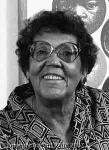Elizabeth Catlett
Elizabeth Catlett
yer: Washington
Doğmuş: 1915
Ölüm: 2012
Biyografi:
Elizabeth Catlett was an African-American graphic artist and sculptor best known for her depictions of the African-American experience in the 20th century, which often focused on the female experience. She was born and raised in Washington, D.C. to parents working in education, and was the grandchild of freed slaves. It was difficult for a black woman in this time to pursue a career as a working artist. Catlett devoted much of her career to teaching. However, a fellowship awarded to her in 1946 allowed her to travel to Mexico City, where she worked with the Taller de Gráfica Popular for twenty years and became head of the sculpture department for the Escuela Nacional de Artes Plásticas. In the 1950s, her main means of artistic expression shifted from print to sculpture, though she never gave up the former.
Her work is a mixture of abstract and figurative in the Modernist tradition, with influence from African and Mexican art traditions. According to the artist, the main purpose of her work is to convey social messages rather than pure aesthetics. While not very well known to the general public, her work is heavily studied by art students looking to depict race, gender and class issues. During her lifetime, Catlett received many awards and recognitions, including membership in the Salón de la Plástica Mexicana, the Art Institute of Chicago Legends and Legacy Award, honorary doctorates from Pace University and Carnegie Mellon, and the International Sculpture Center's Lifetime Achievement Award in contemporary sculpture.
Catlett was born and raised in Washington, D.C. Both her mother and father were the children of freed slaves, and her grandmother told her stories about the capture of blacks in Africa and the hardships of plantation life. Catlett was the youngest of three children. Both of her parents worked in education; her mother was a truant officer and her father taught in Tuskegee University, the then D.C. public school system. Her father died before she was born, leaving her mother to hold several jobs to support the household.
Catlett's interest in art began early. As a child she became fascinated by a wood carving of a bird that her father made. In high school, she studied art with a descendant of Frederick Douglass.
Catlett completed her undergraduate studies at Howard University, graduating cum laude, although it was not her first choice. She was also admitted into the Carnegie Institute of Technology but was refused admission when the school discovered she was black. However, in 2007, as Cathy Shannon of E&S Gallery was giving a talk to a youth group at the August Wilson Center for African American Culture in Pittsburgh, PA, she recounted Catlett's tie to Pittsburgh because of this injustice. An administrator with Carnegie Mellon University was in the audience and heard the story for the first time. She immediately told the story to the school's president, Jared Leigh Cohon, who was unaware of it as well and deeply appalled that such a thing had happened. In 2008, President Cohon presented Catlett with an honorary Doctorate degree and a one-woman show of her art was presented by E&S Gallery at The Regina Gouger Miller Gallery on the campus of Carnegie Mellon University.
At Howard University, Catlett's professors included artist Lois Mailou Jones and philosopher Alain Locke. She also came to know artists James Herring, James Wells, and future art historian James A. Porter. Her tuition was paid for by her mother's savings and scholarships that the artist earned, and she graduated with honors in 1937. At the time, the idea of a career as an artist was far-fetched for a black woman, so she completed her undergraduate studies with the aim of being a teacher. After graduation, she moved to her mother's hometown of Durham, NC to teach high school.
Because Catlett became interested in the work of landscape artist Grant Wood, she entered the graduate program of the University of Iowa. There, she studied drawing and painting with Wood, as well as sculpture with Henry Stinson. Wood advised her to depict images of what she knew best, so Catlett began sculpting images of African-American women and children. However, despite being accepted to the school, she was not permitted to stay in the dormitories, instead having to rent a room off-campus. One of her roommates was future novelist and poet Margaret Walker. Catlett graduated in 1940, one of three to earn the first masters in fine arts from the university, and the first African-American woman to receive the degree.
In 2006, Kathleen Edwards, the curator of European and American art, visited Catlett in Cuernavaca, Mexico and purchased a group of 27 prints for the University of Iowa Museum of Art (UIMA). Catlett donated this money to the University of Iowa Foundation in order to fund the Elizabeth Catlett Mora Scholarship Fund, which supports African-American and Latino students studying printmaking. Elizabeth Catlett Residence Hall on the University of Iowa campus is named in her honor.
More...
Wikipedia link: Click Here














